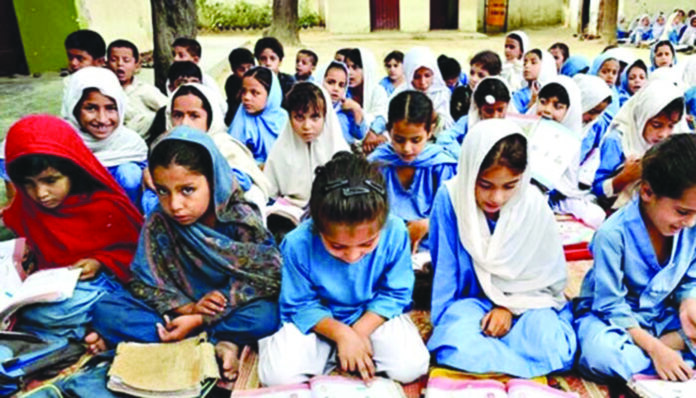Declaring education emergency by successive government’s chief executives and in the same breath vowing to eliminate all challenges ailing education now seem farcical to listen to. Herculean tasks — such as education — are bound to be achieved, but the quest to have the last laugh at the end of the term, consecutive governments transfer the end-to-end encrypted message to the next one to keep the public under the heel of ignorance since that is the very tactic the elite — or status quo — invests in and endeavours for. The relatively poor performance to scale up the graph of literacy is not the only flaw the consecutive governments — preceding ones too — should be taunted for, but is the most pressing one.
Dwindling children’s enrollment in schools, soaring number of out-of-school children, sheer negligence of policymakers on creating visionary plans, utter irresponsibility of curriculum designers on excluding the contemporary in-demand skills, corrupt hierarchical surveillance mechanism and extra surveilling veneer further exacerbates the situation. Plus, the obsolete curriculum and other so-called innovative improvement projects fall prey to the rotten system and ergo ground level implementation remains a subject to manipulation and a means of extra leverage.
Since the actions — aforementioned — have consequences, the final degree achieved by the student is eligible to be dumped in since the minimal requirements is what usually falls short to be hired despite years of investment of time and resources. The very intent to eliminate the educational malaise has been missing, and thenceforth illiteracy haunts all other socio-economic fronts. With 26.2 million children currently out-of-school, the acclaimed 58 percent literacy rate in the country seems a state patronised figure with a heavy dose of exaggeration.
The constitutional non-compliance is pervasively present here, too, since the Constitution promises free and compulsory education to all children aged ranging from 5 to 16 under Article 25-A. Notwithstanding, half of the school-going-aged children are labouring in different sectors, implying government’s apathy and non-seriousness. What is Constitutionally promised — getting every child educated — remains in practical diet, whereas, what is Constitutionally banned — child labour — flourishes overwhelmingly, indicating utter apathy and down-the-line irresponsibility. Yet, the successive governments chin up on doing everything that could be done, nothing seriously done though.
The uneducated and unskilled youth is a growing debris for the future set-ups since all the praxes to improve the situation are resulting in greater disorder. Overall education status is improved provided the system, surveillance and so-called symposiasts are sound and safe — in intention and action. The case with Pakistan has been otherwise and the results are megalomaniac for powerful and miserable for the public.
Pedagogically paralyzed teachers, corrupt and heist-supporting recruitment mechanism, undue advantage to influential in recruitment process, merit negation and bid promotion are some of the centrifugal forces pushing literacy privilege away from the underprivileged, destituted population — and that is perhaps the only weapon the penurious populace can battle with against abject poverty and back-breaking inflation.
The very means of negating schism — education — between the privileged and underprivileged has been in play to bring greater schism between the two.
The very apparatus to transcend the traditional bulwarks of division has brought nought except turning into a centripetal force to bring back the square one.
Education has traditionally been a medium of modernization, an apparatus of leading far in terms of socio-economic and political affairs, and a mediator in bringing peace between the archaically separated, now arch rivals — marginalised and empowered. Conversely, in the land of the pure, that very medium has been in reverse mode.
Though the system is systematically deprived of potentializing the untapped capabilities on a larger scale, narrowed down, rural area’s moguls add another veneer of restrictions for their reign longevity, and personal privilege. Pakistan’s mechanism of educating the population has always been a source of personal gain in a hierarchical order and that, in response, fuels social stratification, inequality, and disenfranchisement.
Ineffective curriculum, copy culture, absence of egalitarian treatment of all trainees, cognitive bias in classes, contemporary skills deprived tutors’ tutelage results in unskilled, educationally handicapped, unbearable debris for the government, and society. Education, in its true sense, is a means of training the previously equaled Kingdom Animalia individual to get fitted in a civilised human society. However, the difference is nought after and before finishing higher education.
Racking one’s brain implies it is sure as shooting the education system won’t be right as rain unless the competent and skilled are not given the education portfolio previously handed to incompetent, unskilled influentials. The complex, expanded education departments serves as the wherewithal of depriving the already deprived and fuels an ambiance of looting public funds transferred for the public good.
Seven and a half decades and counting, educating the public, an otherwise easily solvable, remains an unsolvable puzzle for successive incumbents since the intention to educate is missing right from the start. The repercussions of leaving the public in illiteracy lurch are horrifyingly frightening, particularly in rural regions since all feudals are shaping an environment and setting a stage for reigning supreme in the exact same way mediaeval European monarchs did: divide right to rule.





















